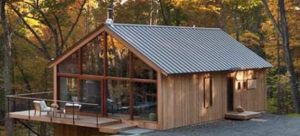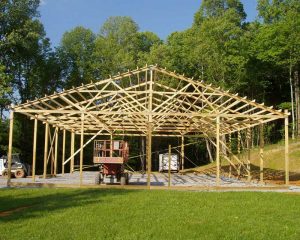For those who want their new post frame building to have an authentic rustic “log cabin” look, split log siding is the most popular answer. Log siding is the way to get the look, without the price of actual logs. Full logs are very expensive, in comparison, and split log siding produces far less wasted material. Vinyl log siding (see yesterday’s blog) is less expensive. But for some, vinyl log siding has the appearance of “not being realistic enough”.
 While split log siding can be painted, in most instances it is left natural with a clear-coat sealant to prevent rot and insect infestation.
While split log siding can be painted, in most instances it is left natural with a clear-coat sealant to prevent rot and insect infestation.
Typically the siding is cut from more decay resistant species, such as white oak, cypress and white or red cedar. Pine is also used, but is not as resistant to decay.
During the milling process, the logs are sawn to result in planks with one natural rounded surface and the other side flat. Typical thicknesses are 1-3/8” and 2-1/2” with widths of 5-1/4”, 7” and 9”. The edges and ends are tongue and grooved to provide a tight installed fit. This type of siding does require regular ongoing maintenance, including re-caulking to prevent moisture damage and resealing to prevent rot decay.
The advantages of split log siding are there is no need to paint or stain; it looks authentic (because it is cut from actual logs) and it is ecologically friendly – wood being a totally renewable resource. It also is going to provide a better insulated wall system than full log walls, as it can be applied to fully insulated walls behind the split logs.
Split log siding on post frame buildings is not without disadvantages. It is very well the most expensive siding, with costs per lineal foot running from two to six dollars. This cost does not include installation, treatments, sealers or caulking. It also has a high degree of difficulty in installation, and may require an experienced professional, rather than a do it yourselfer.
Want the most authentic log look possible for your new pole building, split logs might be the answer!









Good